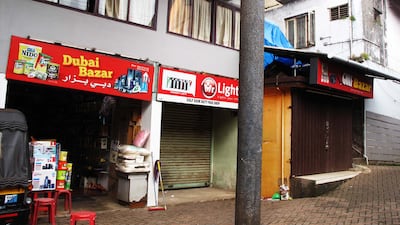Culture shock might be a common reaction for visitors to India, but for UAE residents who visit Kerala, another response might be a vague sense of geographical confusion. Wandering out of my hotel in Kannur in search of a bottle of water, the first shop I saw was called Dubai Bazar. Next to it was Gulf Souq and Gulf Bazar.
As the state that has traditionally provided the bulk of the Indians working in the UAE and the other Gulf countries, it is clear that those who joined the expatriate workforce brought more than just their remittances home with them: they also brought back the ideas they encountered.
This was clear from Kerala standing out from the other parts of India for having building techniques of a kind dominant in the Gulf states. Some structures housed restaurants where shawarmas were served instead of the ubiquitous South Indian thalis.
This slightly unsettling mix of the foreign and the familiar reflects the tradition dating back to the pre-Islamic era, when the proximity of the spice-growing regions of southern India to the natural ports on the country’s west coast attracted Arab traders.
Once oil revenues made the Gulf an attractive destination for expatriate workers, those existing connections meant Keralites dominated the ranks of those coming from India. The remittances they sent back meant it was now one of the most prosperous parts of the country.
I can’t even begin to imagine what Keralites must think when they arrive in the Gulf. Their home is the epitome of tropical lushness, with coconut-laden palms swaying in warm breezes and monsoon-fed greenery threatening to overtake everything – hardly a description anyone would apply to the UAE.
But the almost universal reaction of those I met in Kerala to learning that I live in Abu Dhabi was a broad smile, nearly always presaging a series of anecdotes about their own years of working in the UAE or another Gulf state.
There were a small number of horror stories about being swindled by unscrupulous agents and substandard working conditions but for the overwhelming majority, these years had given them financial security and set them up for life, with a home they owned or with a business started with capital earned in the Gulf.
Working overseas was also a time of freedom between finishing their studies and returning home to the responsibilities of marriage and raising a family.
It reminded me of the Australian and New Zealand habit of heading to London to work for a few years, usually in badly-paid jobs and in overcrowded accommodation, all of which was considered part of the adventure for those raised in the safe and predictable streets of suburbia.
I’d travelled to Kerala to watch a theyyam festival, a spectacular form of Hindu ritual worship conducted in sacred groves in the north Malabar region.
For this, I’d hired a guide who – inevitably – was able to recount fond tales of working in the Gulf. After working as an oilfields engineer in Saudi Arabia, he moved to Dubai for six years until losing his job during the global financial crisis and had since been working in Yemen until the instability there forced him to return home.
I stayed with his family in a substantial home that was clearly in a well-to-do part of town. He had it built using his savings from the Gulf, and he pointed out other similarly grand homes on the street and told me the various Gulf countries in which the owners had worked or were still working: the UAE, Qatar, Kuwait and Saudi Arabia.
Even if the availability of work for him was a little scratchy now, owning the house outright ensured his family would continue to enjoy a reasonable minimum standard of living.
The ultimate comment of the way Gulf remittances underpin the Keralan economy came from an unexpected source. As we drove away from his home to the theyyam festival, we encountered some labourers working on a neighbouring property.
“They’re from Karnataka,” he said. “They come here because the wages are higher than at home.”
That was Kerala in a nutshell. Remittances from Keralite expatriates in the Gulf had buoyed the local economy to the point where the state relied on the labour of “expatriates” from another part of India.
JHenzell@thenational.ae

